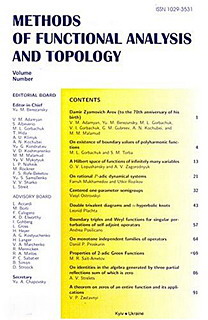Vol. 21 (2015), no. 3
Compressed resolvents of selfadjoint contractive exit space extensions and holomorphic operator-valued functions associated with them
MFAT 21 (2015), no. 3, 199-224
199-224
Contractive selfadjoint extensions of a Hermitian contraction $B$ in a Hilbert space $\mathfrak H$ with an exit in some larger Hilbert space $\mathfrak H\oplus\mathcal H$ are investigated. This leads to a new geometric approach for characterizing analytic properties of holomorphic operator-valued functions of Krein-Ovcharenko type, a class of functions whose study has been recently initiated by the authors. Compressed resolvents of such exit space extensions are also investigated leading to some new connections to transfer functions of passive discrete-time systems and related classes of holomorphic operator-valued functions.
Percolations and phase transitions in a class of random spin systems
MFAT 21 (2015), no. 3, 225-236
225-236
The aim of this paper is to give a review of recent results of Yu. Kondratiev, Yu. Kozitsky, T. Pasurek and myself on the multiplicity of Gibbs states (phase transitions) in infinite spin systems on random configurations, and provide a `pedestrian' route following Georgii–Haggstrom approach to (closely related to phase transitions) percolation problems for a class of random point processes.
On complex perturbations of infinite band Schrödinger operators
MFAT 21 (2015), no. 3, 237-245
237-245
Let $H_0=-\frac{d^2}{dx^2}+V_0$ be an infinite band Schrödinger operator on $L^2(\mathbb R)$ with a real-valued potential $V_0\in L^\infty(\mathbb R)$. We study its complex perturbation $H=H_0+V$, defined in the form sense, and obtain the Lieb-Thirring type inequ\-alities for the rate of convergence of the discrete spectrum of $H$ to the joint essential spectrum. The assumptions on $V$ vary depending on the sign of $Re V$.
On Fourier algebra of a locally compact hypergroup
A. A. Kalyuzhnyi, G. B. Podkolzin, Yu. A. Chapovsky
MFAT 21 (2015), no. 3, 246-255
246-255
We give sufficient conditions for the Fourier and the Fourier-Stieltjes spaces of a locally compact hypergroup to be Banach algebras.
Inverse spectral problems for Jacobi matrix with finite perturbed parameters
MFAT 21 (2015), no. 3, 256-265
256-265
For Jacobi matrices with finitely perturbed parameters, we get an explicit re\-presentation of the Weyl function, and solve inverse spectral problems, that is, we recover Jacobi matrices from spectral data. For the spectral data, we take the following: the spectral density of the absolutely continuous spectrum, with or without all the eigenvalues; the numerical parameters of the representation of one component of the vector-eigenfunction in terms of Chebyshev polynomials. We prove that these inverse problems have a unique solution, or only a finite number of solutions.
The multi-dimensional truncated moment problem: maximal masses
MFAT 21 (2015), no. 3, 266-281
266-281
Given a subset $\mathcal K$ of $\mathbb R^d$ and a linear functional $L$ on the polynomials $\mathbb R^d_{2n}[\underline{x}]$ in $d$ variables and of degree at most $2n$ the truncated $\mathcal K$-moment problem asks when there is a positive Borel measure $\mu$ supported by $\mathcal K$ such that $L(p)=\int p\, d\mu$ for $p\in \mathbb R^d_{2n}[\underline{x}]$. For compact sets $\mathcal K$ we investigate the maximal mass of all representing measures at a given point of $\mathcal K$. Various characterizations of this quantity and related properties are developed and a close link to zeros of positive polynomials is established.
Tannaka-Krein duality for compact quantum group coactions (survey)
MFAT 21 (2015), no. 3, 282-298
282-298
The last decade saw an appearance of a series of papers containing a very interesting development of the Tannaka-Krein duality for compact quantum group coactions on $C^*$-algebras. The present survey is intended to present the main ideas and constructions underlying this development.


